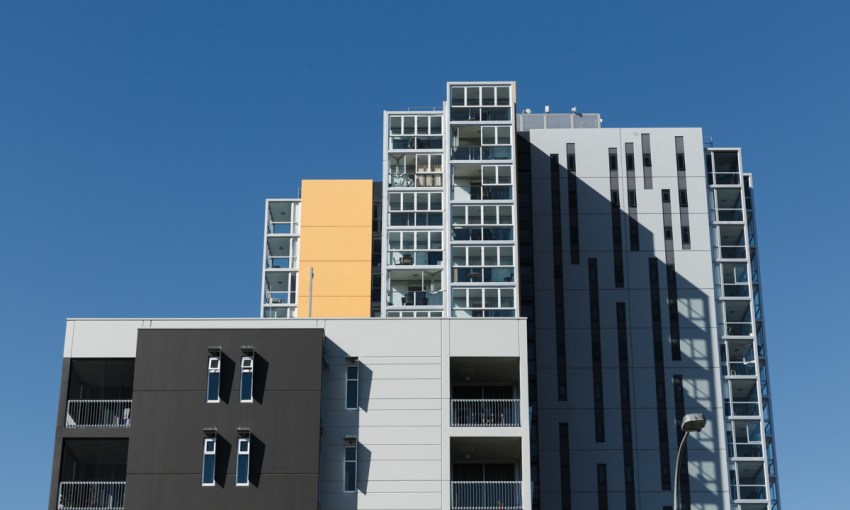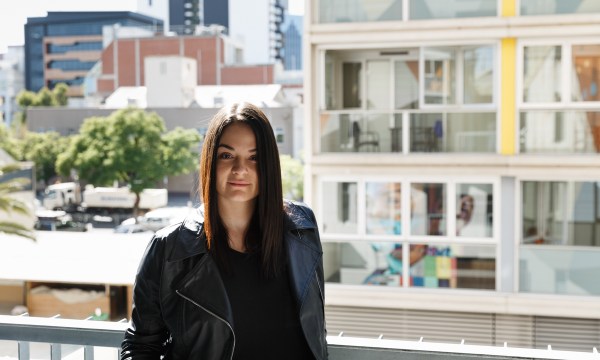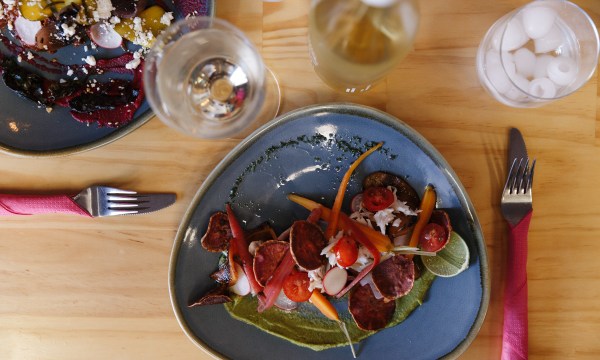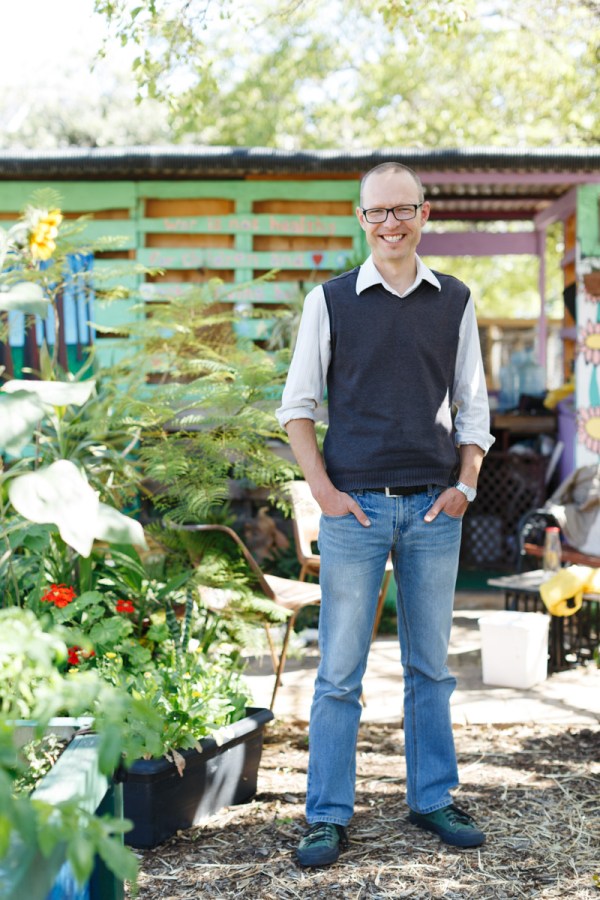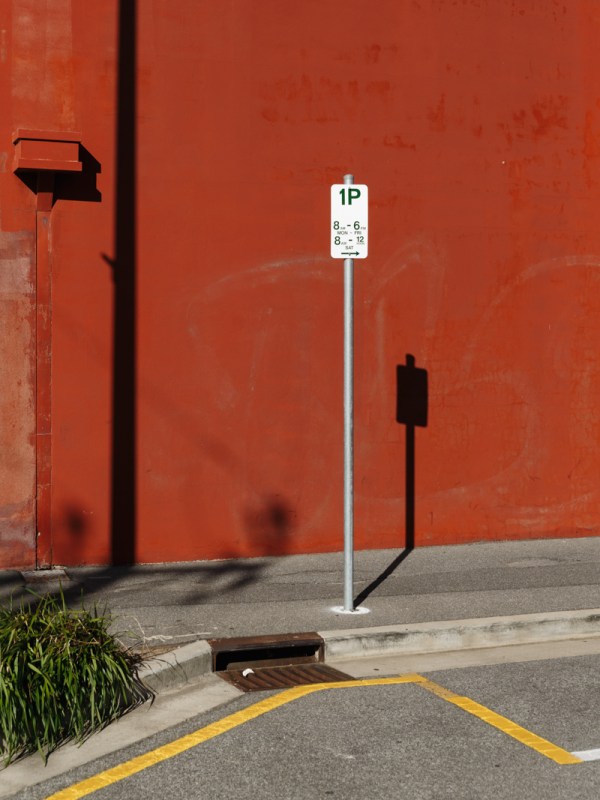Morphett Street is so far from the minds of Adelaide locals that it carries minimal traffic – even at peak hour. But the dull arterial strip of the past is rapidly turning into the city’s largest residential precinct, with restaurants and retail to match.
Not quite Chinatown
The point where Franklin Street meets Morphett Street would, until recently, have best been described using two adjectives – old and sparse.
It’s a hard spot to call to mind, because it’s defined by very little except perhaps the old (no longer in use) bus station, the old Balfours factory and the old (but cheerful) backpackers on the corner. Between these questionable icons lie wide arterial roads and footpaths, populated by very little – sometimes a person, maybe the odd weed making its way through a crack in the pavement, but mostly – just nothing.
More than once during our conversations about the area, Jaycar Electronics was mentioned as a major reason for people to visit. It seems the national electrical components retailer has long been introducing Adelaideans to this otherwise sleepy piece of the CBD.
The quiet nature of this part of town is surprising, because it’s smack bang between two city hubs – Chinatown and Hindley Street.
But it seems the Adelaide business community has woken up to the possibilities of the precinct and change – now it’s happening – is progressing rapidly.
From a square block which just a year ago had few attractions beyond the Publishers Hotel and the rather excellent Franklin Hotel, has sprung a place with burgeoning retail and hospitality credentials and a massive incoming residential population.
Tracking which came first is tricky. Logically, one would assume that the news of the incoming apartment towers – there is rumoured to be six 20 storey-plus monoliths in development – would have attracted businesses, but it seems there were other factors pushing new tenants like national furniture retailer Matt Blatt into the area.
“I wasn’t part of finding the location but I do know they looked everywhere in Adelaide, particularly they looked in North Adelaide, The Parade, King William Road, in the city as well,” says Ehren Ozimek-Coles, Matt Blatt Adelaide’s showroom manager.
“The reason they were attracted to this building was they wanted it to be a destination store, not a heavy foot traffic store. We wanted a large store for Adelaide, it being the only store in this city. We can hold more stock, more of the range. This is 1000m2 and it’s hard to find a space that big in the city.”
Housed in the former Families SA office on Morphett Street, in a building which is more than 100 years old, Matt Blatt’s long, busy, colourful shop front has been key to changing the atmosphere of the area.
Others who are contributing to the transformation have been similarly attracted by the real estate. Directly across Morphett Street from Matt Blatt is a strip of restaurants that could be the start of a multi-cuisine culinary precinct.
Long-term tenants Hong Kee Chinese restaurant were joined by Gouger Street institution Nu Thai last year in a bid to upsize. Now, an Indian restaurant and modern Italian eatery are moving in too.
Owner of Antica Pizzeria, Anthony Crea, decided to open his second location on this block for a combination of reasons, but the size of the real estate was also chief among them.
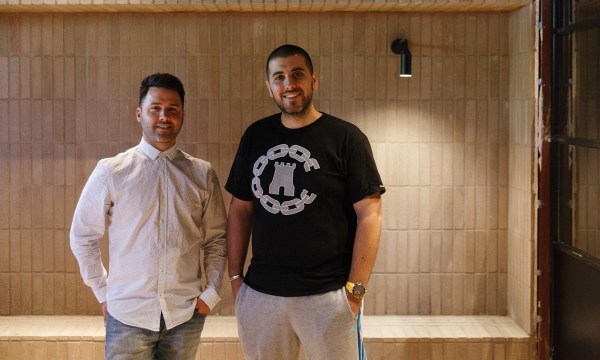
Antica owner Anthony Crea (right) and Ryan Genesin – who is responsible for the design of the new restaurant
“It’s a much bigger area I’m dealing with here – down in the main hubs of Adelaide the size of outlets aren’t really there,” he says.
“We’re going for the big location, because we wanted the kitchen space to cater for making pizza dough and fresh pasta for both this shop and the Hyde Park location, and to look at office catering as well.”
It seems that Adelaide is now finally home to a level of demand large enough to justify the use of the old buildings along this strip, which are too big for regular high street-style hole in the wall cafés or boutiques, but too small for something like a supermarket or chemist.
The confidence demonstrated by the use of these properties, many of which have been empty on and off for years, is no doubt thanks to the city’s revitalised evening scene which has developed over the last few years.
Anthony is hopeful that he and Antica will be at the leading edge of another transformation – the likes of which have been seen previously on streets such as Leigh and Peel, but not so much on four-lane highways like Morphett.
“I guess for me it was about just trying to create a new hub in the city,” says Anthony.
But Anthony is not simply optimistic. He’s been running a successful business in Hyde Park for the last two years, and that suburb is no longer the thriving food precinct it once was. He’s not being naïve in opening Antica part two here – instead he’s being strategic.
His new restaurant, which has a textural, restrained aesthetic courtesy of Ryan Genesin of Genesin Studio, is specifically designed to appeal to the corporate and after-work crowd, with quick lunch specials and a cocktail bar set-up to help people segue from post-work drink to full blown dinner of wood oven pizza or house-made pasta.
As Anthony points out, his location is conveniently on the escape route from work for those employed in the CBD. And he’s also right in saying that he’ll soon have a ready-made clientele right next door.
‘With all the apartments going up down here as well – there’s going to be a lot of residential… And for the style of food that we have, we’re the only ones on this side of the city who can actually offer it.”
For their part, the apartment developers are happy to use the arrival of these fresh-faced businesses as a selling point for the great swathes of accommodation that will be available in the coming years.
Not that managing director of Zhentang Group Nicho Teng – who is responsible for the yet-to-be-constructed West Franklin apartments – thinks the area needs much more to make it attractive.
“I thought it was the best residential site – the best,” says Nicho when asked why his company decided to take over the old Balfours factory site, which had been languishing under an unused development license held by Urban Construct.
“We [in Adelaide] have two precincts that can be the best residential precincts in my understanding. One is on South Terrace with the King William Street corner… And the other one is over here.
“This one has more connection to our city, which includes obviously the university, new hospital, TAFE SA art school, Oval, Convention Centre. We just walk to the CBD East and we walk to the Central Market and Chinatown there – connection wise it’s second to none. It’s integrated from the commercial, education, lifestyle and entertainment aspects. I think it’s the perfect location.”
Existing residents seem to agree with Nicho’s assessment. Tenille Hellier has been in her apartment, located in a building tucked just north of Nicho’s development site, since December last year. Having re-located from the eastern side of the city, she’s found the area is perfect for her busy life where she moves between two jobs and a seemingly endless diary list of coffee, brunch, lunch and dinner dates.
“I certainly love the social side of things, so I love being able to go out to [Café] Troppo and all those sorts of things and catching up with friends,” she says.
“I’m from Melbourne originally… this is just really central for me. It makes it really easy for someone like me who doesn’t have family in South Australia to be able to live a really fluid, fun life at my age in Adelaide.”
Tenille’s apartment is part of the Mellor Street complex run by Common Ground – an organisation that provides affordable housing to lower income earners like Tenille and also offers housing and support services to people who have been homeless.
While Tenille loves the area and says she can easily find everything she needs within walking distance, there will no doubt be higher demand for amenities as hundreds of people begin to move in.
Just one among many upcoming developments, West Franklin alone will be bringing a total of 500-plus homes to the neighbourhood across its two towers, both of which top out above 20 storeys.
When those residents arrive, they’re going to need more than new furniture and pizza, although those are two of life’s essentials. In the mode of most considered high density living, West Franklin will incorporate a lot of the other important bits and pieces – a gym, pool, rooftop bar, supermarket and coffee outlet – into the building itself.
But sometimes the urge to venture beyond the building foyer will no doubt strike Nicho’s future residents, and when they step foot on Franklin Street’s pavement they’ll notice some of the deficiencies already becoming obvious to the precinct’s pioneers.
“Car parking is everyone’s concern no matter where we go,” says Anthony. And while this won’t bother residents who will have dedicated spaces if they have a car at all, it might well bother their friends when they visit – just as it bothers those visiting Matt Blatt.
“Of course car parking is a problem,” says Ehren. “It’s $14 a day for staff early bird and that’s the cheapest I can find. And then for our customers, yeah, it’s bad. They run in and go, ‘I have a half hour park’.”
These kind of facilities will certainly need to begin appearing if the area is going to sail through its evolution without taking several steps back on the way to moving forward. There are a few other public facilities on Ehren’s wish list as well.
“With a little bit of grass and green – if they did that along here and along the median strip it would become a street that people want to stay in,” he says. “And more funky cafés without a doubt… for staff and for customers – cafés bring in people.”
Nicho is confident the current trickle of businesses will turn into a flood – “The business will come out to seize the opportunity,” he says – but for the early adopters who have been ensconced near or off the main drag for a while, life will carry on as usual until the waves of residents and new ventures arrive.
These more established locals are making their own luck. Café/restaurant/bar Mama Jambo occupies the Eliza Street warehouse just off Franklin Street that is likely already familiar to readers from its former lives as Hello, Yes and Tooth and Nail.
Owners Connie Mmadike, Troy Bellchambers and Caroline Mosha took over the space with a plan to be as useful as possible to the existing local community.
“We’re just focussing on what people need – so I’m talking to the customers and asking them what they need,” says Connie. “Because there’s a lot of little businesses opening up and I think that’s not competition – it’s actually good for us.”
Open for breakfast and lunch Monday through to Saturday and in the evenings on Thursday, Friday and Saturday, the team is programming live music and open mic nights in an attempt to kickstart the precinct’s transformation into a day and night zone.
“I’m European, Caroline and I are married to African men – in those places there’s a real sense of community and we don’t really have that here – it’s very autonomous,” says Connie.
The seed of a local, connected community is, in reality, one of the things the Morphett-meets-Franklin area has had since well before the arrival of the latest apartment blocks, restaurants and retail.
Along with Mama Jambo, there are a few long(er) standing businesses and organisations in the area who have been battling successfully against the grey, empty streets by which they’re surrounded.
The Joinery opened here almost exactly a year ago in June of 2015 and it does what it says on the box – joins people together – in this case specifically to tackle issues of environmental concern.
Spearheaded by the Conservation Council SA, The Joinery has heralded one of the most striking visual changes in the area. After overhauling and moving into the old bus station depot, the team has worked with residents and staff of Common Ground’s Franklin Street apartments to establish a community garden.
The garden is proving to be one of the most effective tools for achieving the aims of the facility, which along with being a co-working space for like minded ventures also hopes to engage more people with sustainability issues.
“If we’re going to connect with and mobilise and inspire South Australians to care for nature, treat the environment as an important issue and actually change behaviour we are going to have to reach out,” says Craig Wilkins, the CEO of the Conservation Council SA.
“What we’re trying to do is actually create something that is beautiful for a start, and the garden is the first step, and then we hope to expand that into more art. Then, with the café – that is deliberately reaching out and enticing people in who perhaps wouldn’t ordinarily come.”
Craig and his colleagues are making connections as part of their work, and they’re starting with their neighbours, which – it turns out – is exactly what the precinct needs.
Their existing collaboration with Common Ground isn’t their only one. Among many other things, The Joinery hosts the Adelaide Community Bicycle Workshop and a Go Get electric car share service supported by the State Government. They’re also working with the Central Market and Christie Walk eco-village to run school tours that canvas sustainability from a different and practical perspective.
And as the Depot Collective – the facility’s recently-opened on-site café – gets established, they’ll be looking to join with other nearby eateries to run sustainable food wastage programs that include public-facing education elements.
It’s these kind of linkages – between organisations and business, business and resident, resident and neighbour – that, if sustained and encouraged by people beyond The Joinery and Mama Jambo, will ensure this block becomes a community, rather than just a cluster of businesses and apartment towers sitting alongside each other.







